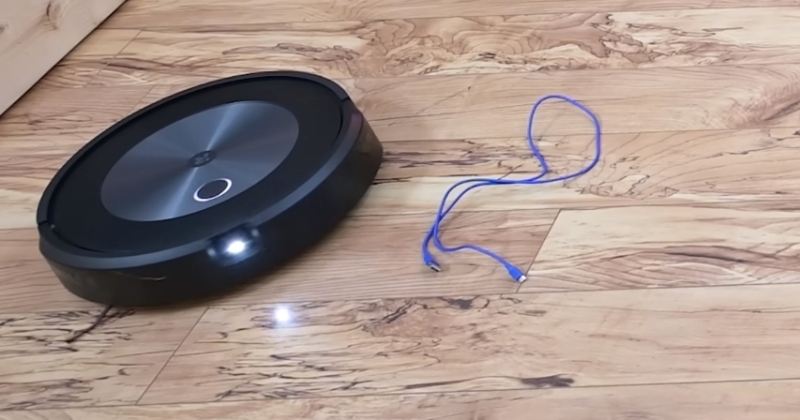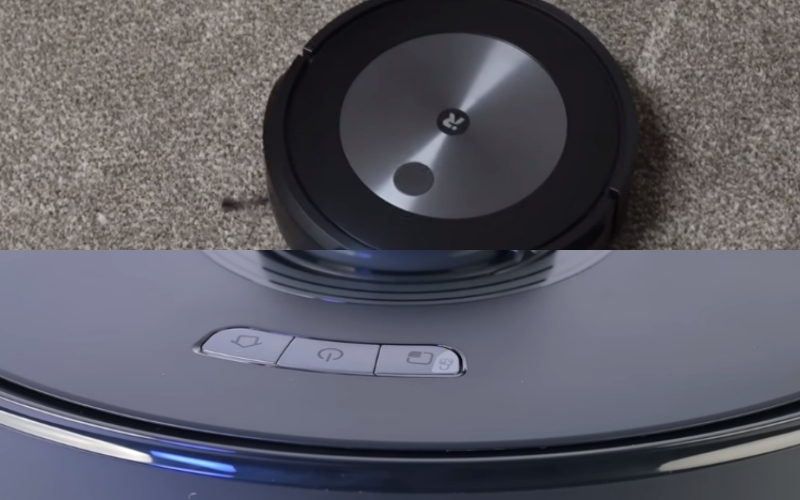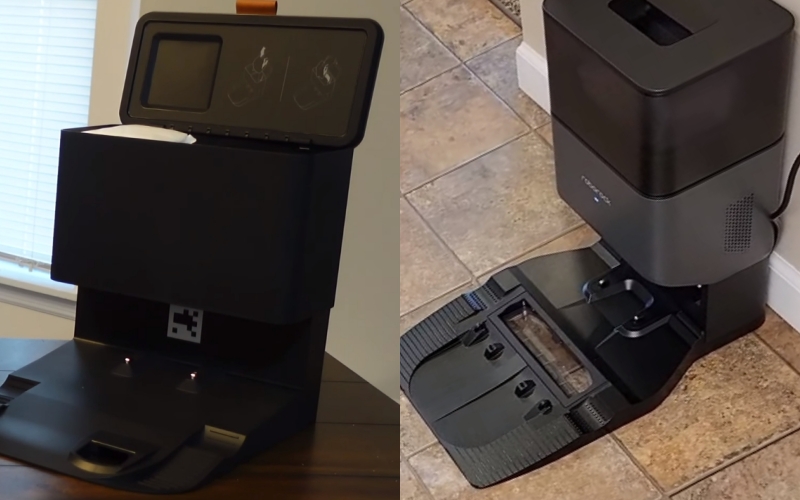Roborock Q7 Max+ vs Roomba J7+ is a tough competition, as they are two advanced robot vacuums that offer smart navigation, powerful suction, and self-emptying features. However, they have some notable differences that may affect your choice. After carefully testing and considering, the Roborock Q7 Max+ appears to be the winner for me.
The Roborock Q7 Max+ is superior thanks to its stronger suction, longer battery life, mopping function, and LIDAR navigation system that maps out the room faster than the Roomba J7+’s camera. Meanwhile, the Roomba J7+ is a formidable rival with a dirt sensor, HEPA filtration, and an excellent AI obstacle avoidance system that can recognize and avoid common objects like socks, shoes, and pet waste.
If you need a good robot vacuum and mop coupled with quick and efficient LiDAR navigation, the Roborock Q7 Max+ is a great option in the price range. Meanwhile, if you prioritize obstacle avoidance, especially when you need to deal with in-house pet waste and the mopping function is optional, the Roomba J7+ is the better investment here. A detailed comparison is demonstrated below. Continue reading for more!
Roborock Q7 Max+ Vs Roomba J7+: Comparison Chart




Roborock Q7 Max+ Vs Roomba J7+: Differences
In the showdown between the Roborock Q7 Max+ vs Roomba J7+, the Q7 Max+ is the winner with a score of 2-1 against the J7+. In my experience, the Roborock Q7 Max+ gives me relatively better cleaning performance and app control. Meanwhile, the Roomba J7+ with the HEPA filter shows the higher efficiency of allergen filtering.
Cleaning performance
Winner: Roborock Q7 Max+
Suction
The Roomba J7+ is ridiculously low for me. Its airflow and suction are significantly below average (see the following table). After taking the suction measurement, I was astounded by the Roomba J7+’s results and even had doubts about its cleaning abilities. Yet, the bot cleaning results are satisfying, which I will talk about later.
In comparison with the Roomba J7+, the Roborock Q7 Max+ has higher suction power, contributing to its cleaning efficiency. It also features three adjustable suction levels, while the Roomba J7+ has only one suction setting.
| Roborock Q7 Max+ | iRobot Roomba J7+ | |
|---|---|---|
| Airflow (cfm) | ~15 | ~ 7 |
| Suction (kPa) | 0.4 | 0.07 |
Carpet and hard floor
For carpet cleaning, robot vacuums are not comparable with stick or upright vacuums. However, the Roomba J7+ and Roborock Q7 Max+ perform well and even better than most of the robot vacs in the market. Specifically, after several tests on carpets embedded sands, cereals, and pet hair, these two bots’ pick-up efficiency reaches 87-90%, very impressive to me.
The higher suction power of the Roborock Q7 Max+ shows to be a critical factor for such a great carpet cleaning efficiency of the appliance. Meanwhile, in the case of the Roomba J7+, it is the main dual brushroll system to compensate for its inferior suction power. With the second brush roller, the Roomba J7+ offers greater surface agitation for better debris-picking-up performance.
For hard-floor cleaning, they work like a charm, collecting fine to medium debris effectively. However, their spinning side brushes scatter things on hard floors quite a bit, so sometimes they cannot collect debris in one pass.
Pet hair
In general, both of the bots deal with pet hair effectively, even on carpets and hard floors. Yet, for me, the Roborock Q7 Max+ is quite better at collecting up turfs of short pet hair than the Roomba J7+. The former can collect pet-hair turfs in one pass owing to its good suction power. Meanwhile, the latter often runs over the turfs and needs more passes to clean up all of them.
Design & Convenience
Tie!
Brush roll system
Two bots feature different brushroll systems. The main brushrolls of Roborock Q7 Max+ and Roomba J7+ are rubber brushes. However, the Q7 Max+ uses a single-brush system, while the Roomba J7+ utilizes a dual-brush system.
Utilizing rubber brushroll helps reduce hair tangling significantly. With short hair strands of ~5 inches, both the Roborock Q7 Max+ and Roomba J7+ can resist hair tangling up to more than 90%. However, with longer hairs of 7-10 inches, they struggle to detangle, which is also a common problem with robot vacuums. Yet, I found that the hair staying on the roller of the Roomba J7+ has a lower amount than on the Q7 Max+ roller. In other words, the Roomba J7+ is better at hair-tangling resistance.
Besides, they all have one side brush with long bristle prongs to decently pull debris from wall edges. However, the side brush of Roborock Q7 Max+ has 5 prongs, instead of a conventional 3-prong side brush like on the Roomba J7+. The more fiber prongs the side brush has, the greater the interaction between the brush and the edges, increasing the edge-cleaning efficiency.

Navigation & Obstacle avoidance
- Navigation & Mapping
In terms of navigating and mapping, I find the Roborock Q7 Max+ performs better than its rival. Thanks to the LiDAR navigation, the Q7 Max+ can map my house more quickly, taking about 40-45 minutes to create the whole floor plan, even in the first trial run. Conversely, the vSLAM navigation technology of the Roomba J7+ takes hours to complete the floor mapping.
Besides, the Roomba J7+ constantly bumps into walls and table and chair legs during the run exploring my house and even after the floorplan was created. This is quite annoying for me, but it is not the case with the Roborock Q7 Max+. The Q7 Max+ with the rotating LiDAR tower does not bump into walls and furniture while mapping the floor and, after that, making vacuuming less frustratingly noisy.
One more thing I prefer about LiDAR navigation is the ability to clean in the evening without leaving the lights on. Thus, I can schedule the Roborock Q7 Max+ to run a thorough cleaning after my family goes to bed. I tested scheduling the Q7 Max+ to clean the whole downstairs at 3:30 AM, and it performed very well without getting stuck.

The Roomba J7+, on the other hand, fails this night cleaning test. As it always crashed into things, it made a lot of loud noises that could wake my family up. Though its front camera has a small LED light, the brightness is not enough for it to function in the dark. That LED light, in fact, supports the Roomba J7+ to realize objects on the floor for better obstacle avoidance efficiency.
Apart from that, both of the bots have cliff sensors that prevent them from falling down the stairs. In addition, they provide great cleaning coverage with multiple passes and rarely miss any spots. They also know where the self-emptying bases are located and return to empty their dirt bins or recharge. After that, they will resume cleaning from where they left off.
- Obstacle avoidance
In the aspect of obstacle detection and avoidance, the Roomba J7+ wins hands down. It can avoid small and light objects perfectly without using its bumper. I placed small kid and pet toys and charging cords on the floor to test the bot’s obstacle avoidance. Well, it impressed me with the ability to recognize things and then go around them. It can also avoid pet waste with different shapes very well, which most robotic vacuums cannot handle.
Unfortunately, the Roborock Q7 Max+ is inferior in this test. The LiDAR can do an excellent job in mapping and navigating but cannot detect small objects staying low on the floors and pet waste. The Q7 Max+ runs over or even picks up and drags the cords along the house.

Therefore, before running the Roborock Q7 Max+, I need to pick up all small objects, such as pet toys, blankets, and phone chargers. So, if your home has a lot of things to avoid and you aren’t very good at tidying items from the floors before cleaning, the Roomba J7+ can be your best buddy.
Additionally, the Roborock Q7 Max+ cannot detect the carpet and rug on the floor when in mopping mode. So, after the Q7 Max+ discovered my home and the map was created, I had to set the carpeted area as the no-mop zone in the app.
Battery life
They claim that the Roborock Q7 Max+ can work for up to 180 mins, and the Roomba J7+’s maximum battery life is 120 mins. However, these numbers are true only if the rooms do not have carpets and many pieces of furniture. In my trial cleaning runs on floor mixing bare and carpeted floors, the maximum runtime for the Roborock Q7 Max+ and Roomba J7+ is around 95 mins and 60 mins, respectively.
| Roborock Q7 Max+ | iRobot Roomba J7+ | |
|---|---|---|
| Battery life | ~95 minutes | ~60 minutes |
| Charging time | ~3 hours | ~2 hours |
Control
Winner: Roborock Q7 Max+
Physical control
The Roomba J7+ has a single button on its top for starting and stopping the vacuum section. Pretty simple. On the other hand, the Roborock Q7 MAX+ has three different buttons, including power/cleaning, spot cleaning/child lock, and dock cleaning. With more control buttons, I can control the bots more easily without having my phone nearby.

App control
The apps of both Roborock Q7 Max+ and Roomba J7+ work fine, but I have a more stable experience with the Roborock app. I often encounter the crashing issue when using the Roomba app.
Both the Roomba J7+ and Roborock Q7 Max+ allows me to save multiple maps, but the J7+ has more saved map number. Specifically, the Roomba J7+ supports me saving up to 10 maps, while with the Q7 Max+, I can save a maximum of 4 maps. The Roomba J7+ is definitely the suitable choice if your home has more than 4 floor levels, or you want to create more floorplans for specific cleaning sessions.
After these bots map my floors, I can open the app and label the rooms, adjust the map, and set the no-go zones so that the bot can know where to clean more effectively. Moreover, the Roborock app offers the option to create virtual walls and no-moping zones, increasing the efficiency in preventing the Q7 Max+ from getting stuck in tight spaces or falling down.
Other things I found helpful in the Q7 Max+ app are the carpet boost mode, adjustable suction levels, and 3D map. When the carpet boost mode is activated, the bot can detect the carpets and automatically increase the suction power for effective cleaning. Then, suction will back to the selected suction strength when the bot transitions to hard floors.

In fact, I do not use the 3D map too often, but this is an interesting feature of the Roborock app. When opening the 3D app, I can easily visualize my room, knowing which furniture the bot has recognized, and then make modifications for more precise maps. Some adjustments I made include changing the furniture position or adding other pieces of furniture to the map.
Another feature that I appreciate about the Roomba J7+ and Roborock Q7 Max+ is that they work with voice assistants, such as Amazon Alexa, Google Home, and Apple Siri. This means that I can use voice commands to tell them to clean specific areas when my hands are occupied with other tasks. They are also very responsive, and I haven’t encountered any problems using voice commands so far.
Cleaning & Maintenance
Winner: Roomba J7+
Both robot vacuums have similar cleaning and maintenance requirements. They can handle hair-wrap issues fairly well, but longer hair can still get tangled on their rollers. Thus, their bottom needs to be checked every two weeks to remove any hair or fur that might be stuck on the edge brush, the roller ends, or the wheels. If left unattended, this can affect the performance of the robots.
Another convenient feature of both robots is that they have self-emptying bases that they can automatically return to when their dirt bins are full. They also resume cleaning after they empty their bins. This saves me a lot of time and hassle, as I don’t have to empty the robot bins every day. Their disposal dirtbags have a large capacity, about 2.4-2.5 liters, estimated to hold dirt for up to 60 days.

However, in terms of the bot’s internal filter, the Roomba J7+ has a HEPA-standard filter, increasing the efficiency of filtering allergens and microparticles in the exhausted air up to 99%. On the other hand, the Roborock Q7 Max+ features the E11 filter, providing a micro-particle filtering efficiency of 95%, according to the brand. Nevertheless, it is less effective in trapping allergens than the HEPA filters. So, I decided to choose the Roomba J7+ as the winner of this round.
One more thing I want to note is that the filters of the Roomba J7+ are not designed to be washable and need replacement after 6 months. Meanwhile, those of the Roborock Q7 Max+ can be rinsed with water and let dry for about 24 hours before being inserted into the bot housing. The dirt bins of both bots are washable under water and should be checked every two weeks to ensure their performance.
Other features
Tie!
Noise levels
These bots make a lot of noise when the base operates the self-emptying, but this takes about seconds to finish, so it’s not a big deal for me. Besides, their vacuuming noise levels are acceptable, about 60-70 dB, depending on the type of surface they are cleaning.
| Roborock Q7 Max+ | iRobot Roomba J7+ | |
|---|---|---|
| Vacuuming | ~58 – 70 dB | ~50 – 66 dB |
| Self-emptying | ~79 dB | ~78 dB |
Mopping function
The Roborock Q7 Max+ can vacuum and mop at the same time, while the Roomba J7+ doesn’t. The mopping performance of the Q7 Max+ is decent for me. It needs several passes to wipe out all the stains in my test. Its water tank is quite modest, about 350 ml, but can handle about 950 square feet of flooring. Shortly, the Q7 Max+’s mopping function is good for daily cleaning and with small dirt stains on floors.
The Roomba J7+ is only for vacuuming, but it is compatible with the Braava Jet M6 for mopping function. If you’re looking for robots with vacuum and mop functions, you can get the bundle of Roomba J7+ and Braava Jet M6 or the Roomba Combo J7+.

Quick Rundown of Roborock Q7 Max+
- 7 Weeks of Hands-Free Cleaning: The Auto-Empty Dock Pure automatically empties the robot after each cleanup, eliminating the need for frequent manual emptying; its 2.5L dust bag holds up to 7 weeks of debris, making it an ideal gift for families and friends
- Deeper Cleaning with Powerful 4,200 Pa Suction: Boasting an impressive maximum suction power of 4,200 Pa, the robot vacuum easily lifts debris and pet hair from floors, extracts dirt from cracks, and deep-cleans carpets; it automatically boosts suction to the maximum when carpets are detected for thorough cleaning
- Twin Cleaning Power: Vacuum and mop at the same time to remove fine dust that vacuuming alone may miss; the vacuum cleaner offers 30 water flow levels, thanks to the electronic pump, allowing you to fine-tune cleaning based on your floor types and preferences
- Clean Smarter with PreciSense LiDAR Navigation: Utilizing extremely accurate LiDAR technology, the vacuum creates precise maps of your home, effectively tracks cleaning routes, and unlocks a range of smart cleaning functions; you can view these maps in 3D and even add furniture and floor materials to virtually recreate your space
- Combined Dustbin & Water Tank: The 470 ml dustbin and 350 ml water tank combination supports longer cleaning sessions without the need for frequent emptying or refilling
Quick Rundown of iRobot Roomba J7+
- CLEANS WHEN AND WHERE YOU WANT– Only iRobot brings you Imprint Smart Mapping allowing you to control and schedule which rooms are cleaned and when, while storing multiple maps for easier cleaning on each level of your home.
- AVOIDS PET ACCIDENTS – WE GUARANTEE IT - IRobot brings you P.O.O.P. (Pet Owner Official Promise). You can rely on your Roomba j7+ to avoid pet waste, or we’ll replace it for free. Additional terms and conditions apply – see iRobot website for details.
- IT DOESN’T JUST LEARN YOUR HOME; IT REACTS TO IT IN REAL TIME. With PrecisionVision Navigation and a camera, your robot identifies and avoids obstacles of all sizes like pet waste, charging cords, socks and shoes to get the whole job done.
- MORE THOUGHTFUL THAN YOU THOUGHT - The Roomba j7+ takes vacuuming off your mind with personalized cleaning suggestions powered by the unique intelligence of IRobot OS. Learns your habits and your routines.
- POWERFUL PERFORMANCE. The 3-Stage Cleaning System packs 10x the Power-Lifting Suction, an Edge-Sweeping Brush gets along walls and corners, and Dual Multi-Surface Rubber Brushes flex to adjust to different floor types. Compared to the Roomba 600 series.
Product Videos
Related Articles to Roborock Q7 Max Plus
Related Articles to Roomba J7 Plus
- Roomba J7+ Vs I3+: Which Self-Emptying Robot Is Better?
- Irobot Roomba J7+ Vs I4+: Review Of A Detailed Comparison
- Roomba J6+ Vs J7+: Is There A Difference Between The Two?
- Shark Ai Ultra Vs Roomba J7+: A Battle Of Intelligent Cleaning Power
- Roomba J7+ Vs Roborock S7: An Ultimate Guide
- Roborock Q5+ Vs Roomba J7+: A Head-To-Head Comparison
- Ecovacs Deebot N8+ Vs Roomba J7+: Can Ecovacs Be An iRobot Killer?
- Roomba J7+ Vs J8+ Detailed Comparison: Is There Any Difference?
- Roomba J7+ Vs I7+: A Honest Review And Detailed Comparison
- Roomba J7 Vs J7+: What Is The Difference?
- Roomba J7+ Vs S9+: Is the J7+ Really a Worth-The-Money Upgrade?
References:
- Roborock Q7 Max+: https://us.roborock.com/products/roborock-q7-max-plus
- iRobot Roomba J7+: https://www.irobot.com/en_US/roomba-j7plus-self-emptying-robot-vacuum/J755020.html

Richard B. Schmidt is a prominent figure in the vacuum cleaner industry, boasting over 15 years of expertise. Armed with a Robotics Engineering degree from Northeastern University and a Master’s in Consumer Science from Harvard, his unique blend of technical knowledge and consumer insights positions him as a sought-after authority in vacuum cleaner evaluation. Richard’s career began at Dyson, where he contributed to the development of innovative vacuum models. Transitioning to advocacy and reviews, he co-founded the first Vacuum-focused blog in 2008, offering comprehensive analysis and user guides for various vacuum cleaners. In 2020, he founded RoboMop.net, providing ongoing insights through columns and buyer’s guides.
